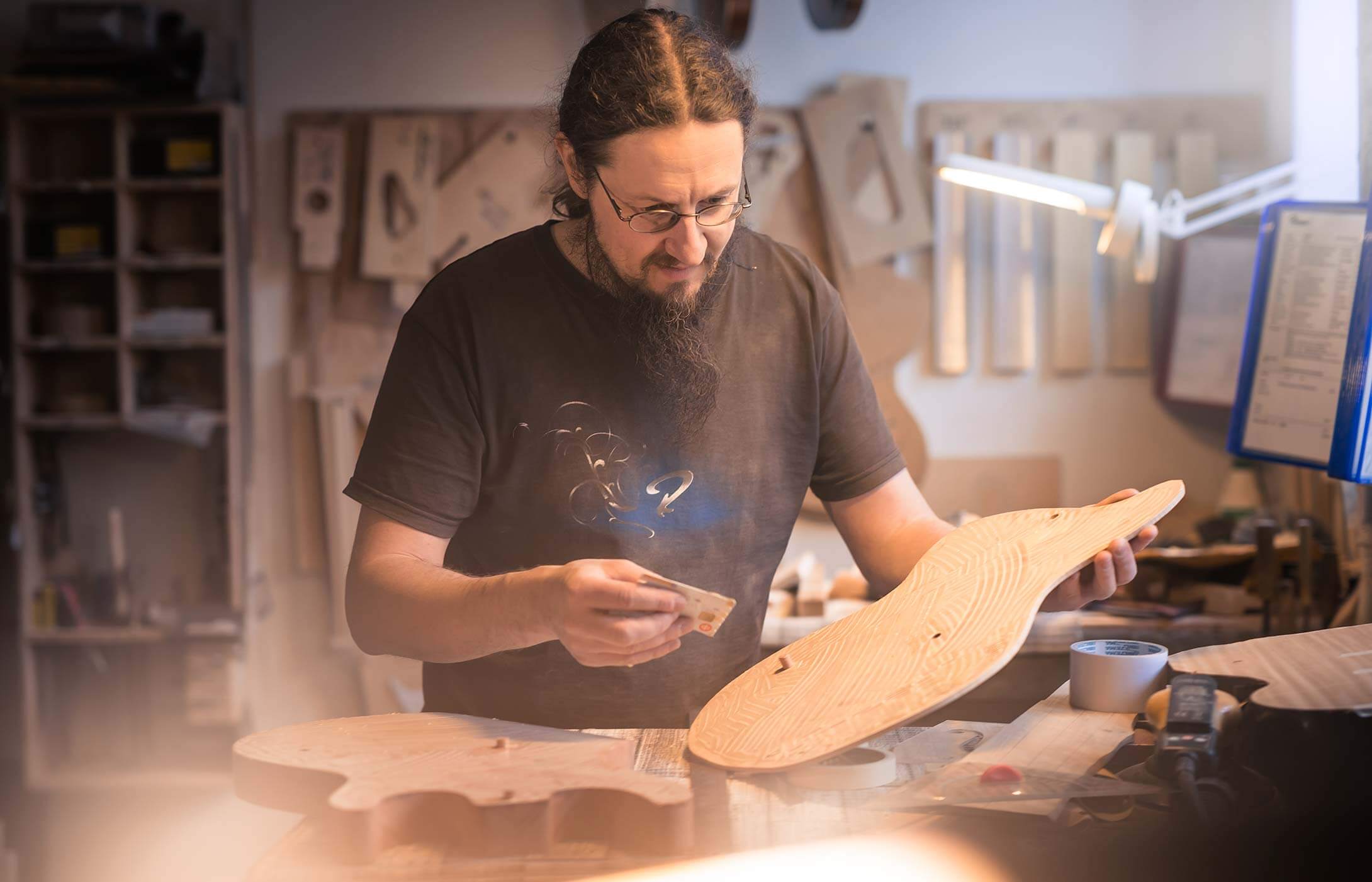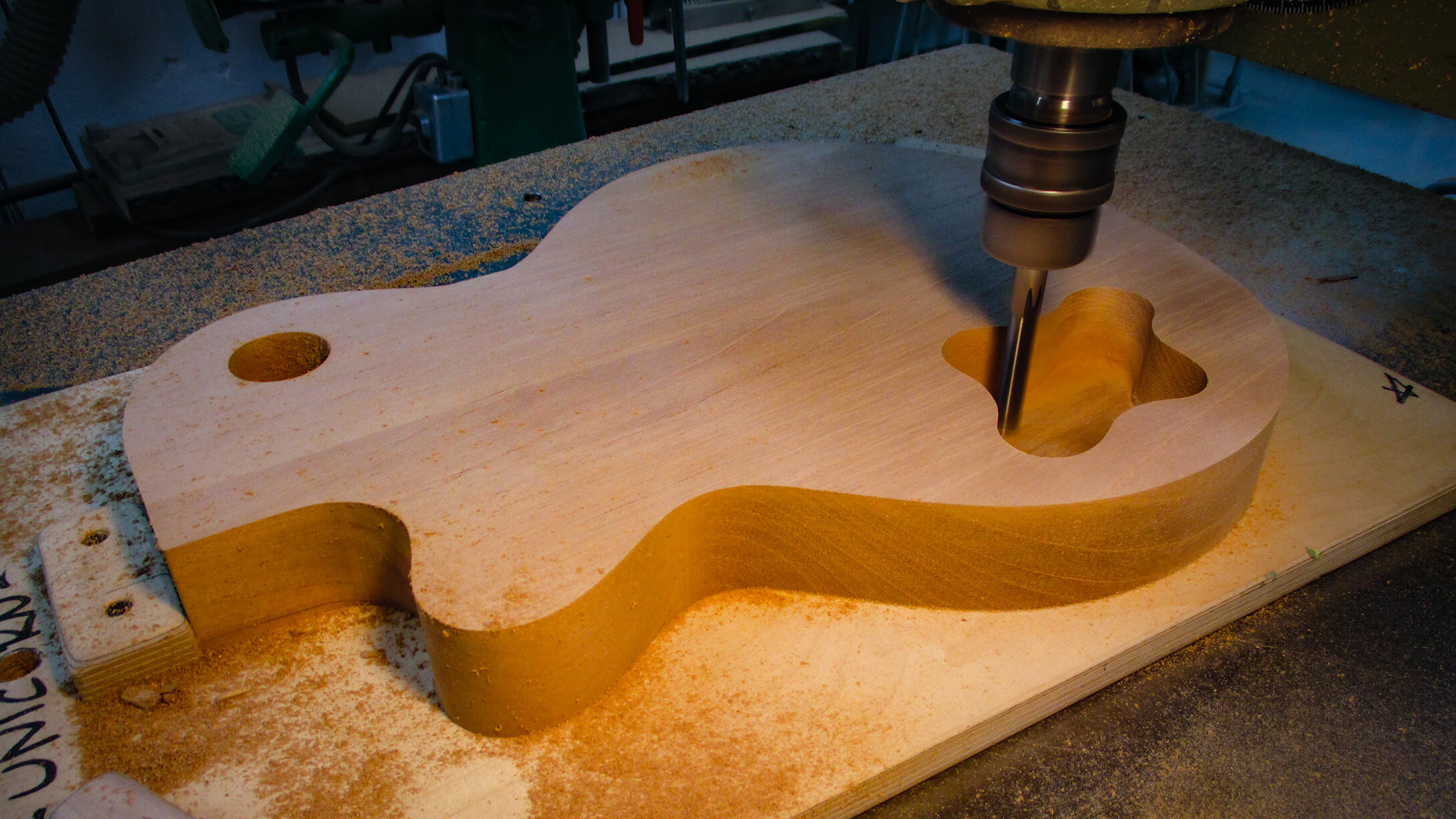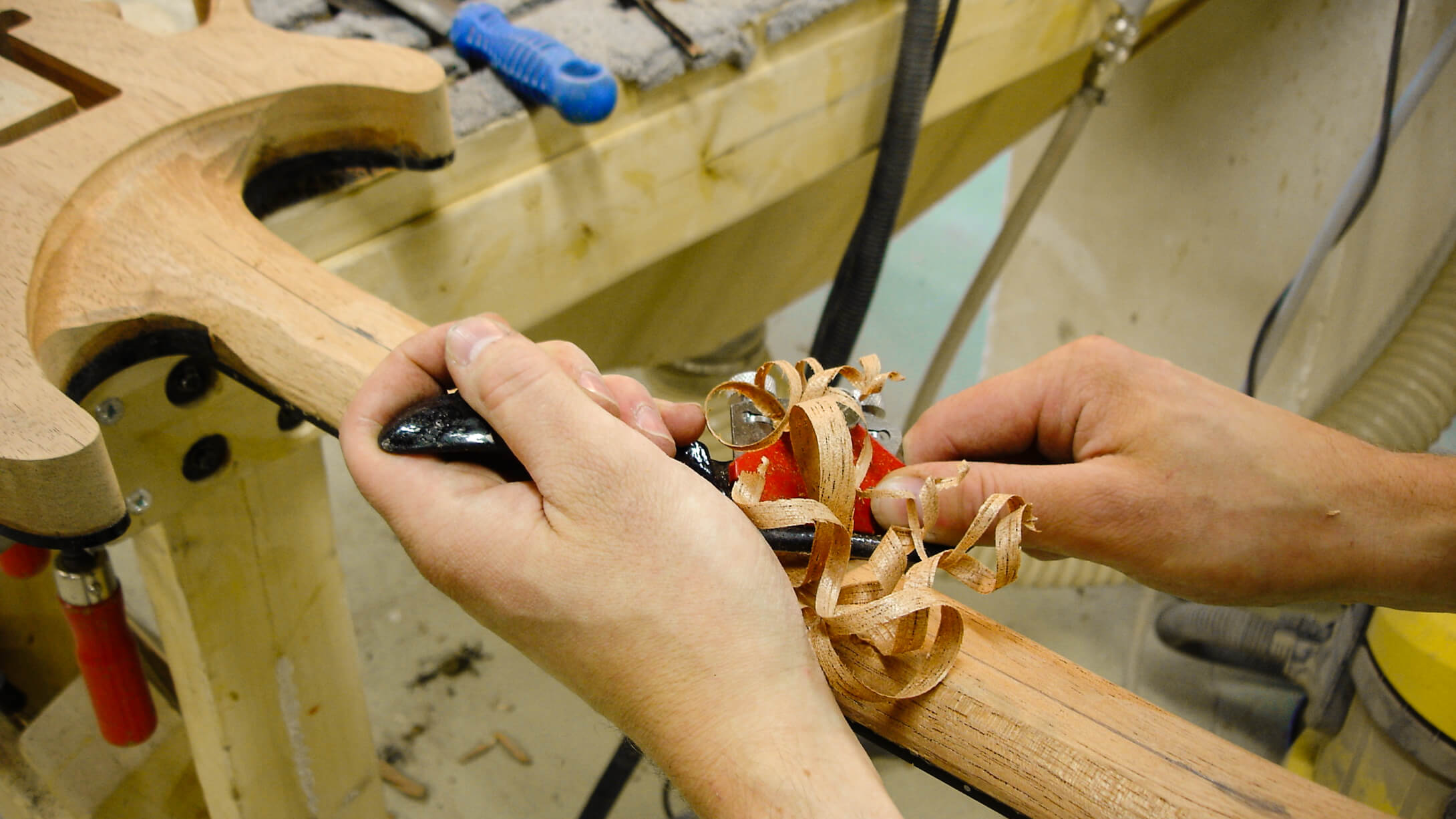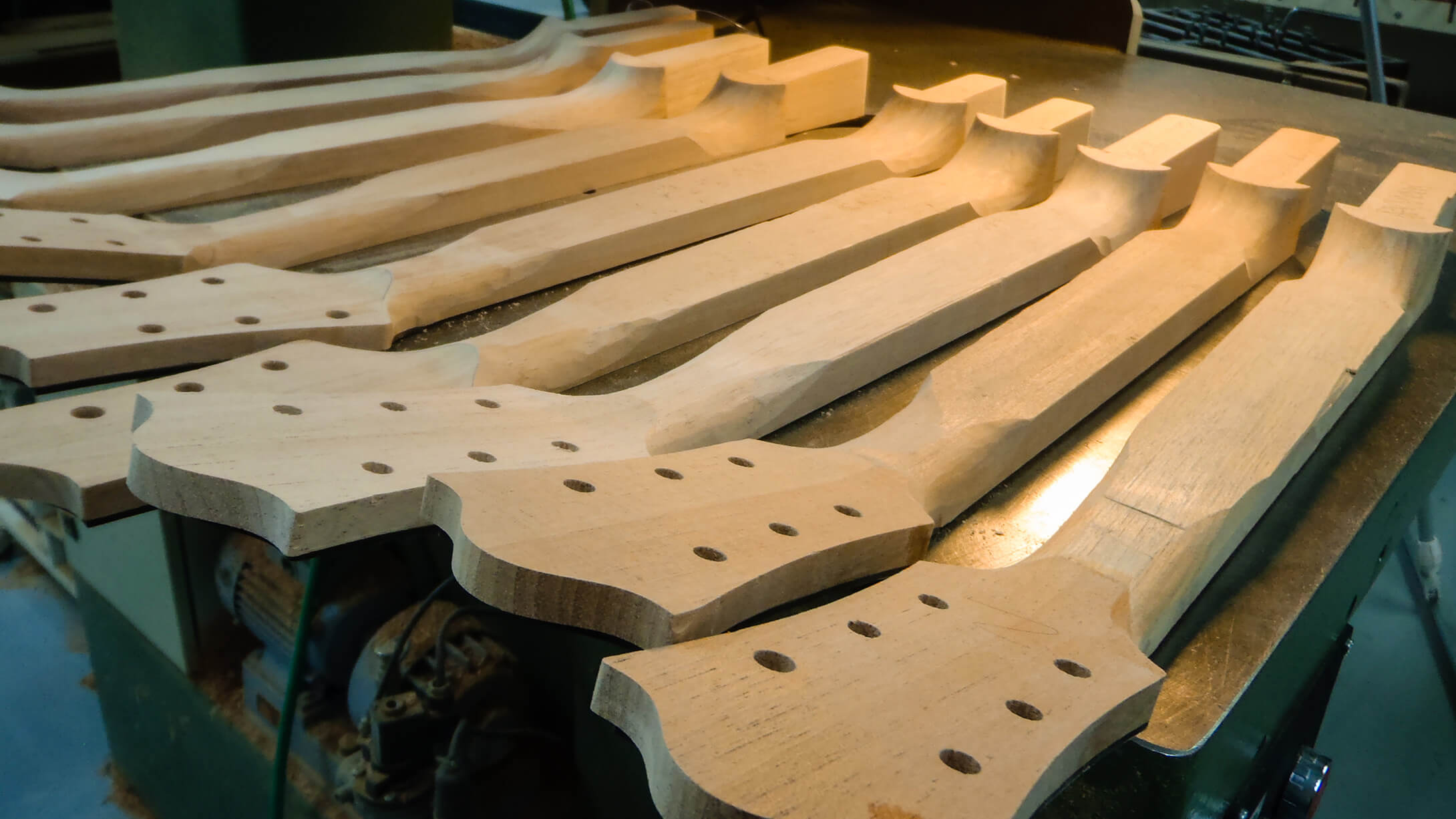
HONDURAN MAHOGANY… OR SPANISH CEDAR?
Old versus new traditions
We all belong to a continuum. We draw from the past – but luckily we’re also capable of renewing ourselves.
Establishing the use of Spanish cedar in electric guitars is one example of my personal renewal processes. By doing so, I wish I have not only generated a new tradition, but also succeeded in contributing a little to the ongoing evolution of the electric guitar.
Observations of an old guitar
I was 22 years old, studying to become a luthier. One day I had an opportunity to visit a collector who owned a 1957 goldtop Les Paul – the only one of its kind in Finland at the time. I picked up the guitar and immediately noticed that it was very lightweight – unlike the more modern Les Pauls I had held in my hands.
I was surprised!
My second observation was, that the acoustic timbre of the guitar was warm – but also loud and open, again unlike the newer Les Pauls, which were darker, muddier, and not so loud. I was surprised! I liked the tonal character of this old guitar a lot – the sound left a lasting impression on me.
Echoes from the 1950’s
I kept bugging my guitar making teachers about it, and learned that the Honduran mahogany Gibson used in the 1950’s was generally lighter than what has been available since late 1960’s. Regardless of this weight increase, most makers, big and small, still preferred to use Honduran mahogany, as it was the traditional choice for this purpose.

ABOUT “VERY IMPORTANT TRADITIONS”
From a cherished tradition…
Emma (my wife) once told me a funny story about a family with a special Christmas tradition. The mother always cut off a certain part of the ham before putting it into the oven. One day she was teaching the art of preparing the Christmas ham to her daughter – who immediately asked: “Why does the slice need to be cut off?”. The mother answered: “ That’s the way it’s supposed to be done – that’s how my mother taught me. It’s important!”. The daughter wasn’t happy with the answer, and called up her grandma, who laughed and explained: “Well I used to cut off a slice, cause our oven was so small that otherwise the ham wouldn’t have fitted in!”.
… to a purposeless habit
The little Christmas ham story is a perfect example of how traditions are often born. A practise that once made perfect sense may transform in time to a purposeless habit.
This is exactly how I felt about using Honduran mahogany in my electric guitars. A superficial solution that compromised the tonal quality and playability of the instrument, because the available wood was not the same as it once had been.
What is a weight relief?
The common solution for factories to try fix the weight problem is to make the body thinner or drill “weight relief” holes in it. This, however, does not generate the same result as having a thicker solid body guitar made of lightweight wood.

THE TURNING POINT – FINDING SPANISH CEDAR
Carve these necks!
I did my trainee period in 1995 at Liikanen Guitars classical guitar workshop. One day their master luthier Kauko Liikanen handed to me two pieces of wood and said: “Carve these necks.”.
Wait… what is this scent?
The pieces looked about the same, weighed about the same – but when working on them, I noticed that one of the necks had an unusual scent. I asked about it, and was told that most of their necks are made of a wood species called Spanish cedar (Cedrela Odorata), that has this very distinct aroma to it.
In this case, however, one of the necks (the one that didn’t smell!) happened to be an old piece of Honduran mahogany, that they sometimes used – if they found light weight pieces. Otherwise, the properties of these wood species were very similar similar.
Spanish cedar in an electric guitar?
This surprising coincidence got me thinking. Similar features as Honduran mahogany – but Spanish cedar is generally lighter. So… how would this stuff work in an electric guitar?
It’s getting exciting!
I went on asking Kauko a flood of questions, and the more answers I got, the more enthusiastic I became. Once properly dried, Spanish cedar is one of the most stable wood materials in the world. It has a unique property of holding a stable inner moisture level even if the climate relative humidity changes dramatically. It is extremely rigid – but light weight.
I even found out from another luthier – Juha Lottonen – that he had made an electric guitar out of Spanish cedar, and in his opinion it worked great.

FIGHT AGAINST WINDMILLS
The Duke
I couldn’t wait to begin experimenting..! I bought enough Spanish cedar for three electric guitar bodies and necks – and eventually built the prototype run of my first original design guitar, the Duke, out of them in 1996-1997.
Something different
When I got the first Duke make of Spanish cedar ready, I totally fell in love with the resonant, rich and beautifully balanced sound of it. There was something different – something unique – about it, too.
Take it or leave it!
For years, making guitars out of Spanish cedar felt like a constant fight against windmills. People kept asking me to make the Duke out of Honduran mahogany – but I refused.
I told them I want to make the best guitar I can, and Spanish cedar is in the recipe – take it or leave it. Luckily, as years went by, more and more players started taking it, rather than leaving it.
CEDRELA ODORATA – SMELLS LIKE CEDAR
Our cornerstone material
Spanish cedar has played an essential role in my guitars throughout my whole career. It is one of the cornerstone materials we use in a lot of different guitars and basses.
Setting an example to others
When I started using Spanish cedar, it was a completely unknown material in electric guitars. Today, more and more younger builders and even some small industrial manufacturers have picked my lead and started offering it in their guitars. Needless to say, I’m happy and proud to have been a pioneer on this field.
What? Not from Spain, not a cedar!
One more piece of trivia for the guitar nerds… As I have learned later in life (confusingly enough!) “Spanish cedar” is neither Spanish nor a true cedar. The latin name “Cedrela Odorata” translates literally “smells like cedar”. Spanish cedar, or cedro, grows in South America. Unlike cedar, it is not a coniferous tree, but a close relative to Honduran mahogany. Who would’ve known!?
Does my guitar need a CITES certificate?
Spanish cedar is currently listed on CITES Appendix III. This means that no CITES certification is needed to be delivered with guitars. Only raw lumber needs to be certified when it’s exported from the country of origin. See more info about the current CITES regulations here.